Building University-Industry Co-Innovation Networks in Transnational Innovation Ecosystems: Towards a Transdisciplinary Approach of Integrating Social Sciences and Artificial Intelligence
Abstract
1. Introduction
- Why should TIC and TUC be looked at as synergetic entities?
- How can the synergy building be theoretically elucidated?
- How can the synergy building be methodologically realized?
2. Why Should TIC and TUC Be Looked at as Synergetic Entities?
2.1. Transnational Innovation Ecosystems
2.2. Universities’ Third Mission
2.3. EU–China Transnational STI Cooperation
2.4. Limitations of Existing Literature
3. How Can the TIC and TUC Synergy Building Be Theoretically Elucidated?
3.1. Helix Models of Innovation
3.2. Institutional Theory
3.3. Social Network Theory
Opinion and behavior are more homogeneous within than between groups, so people connected across groups are more familiar with alternative ways of thinking and behaving. Brokerage across the structural holes between groups provides a vision of options otherwise unseen, which is the mechanism by which brokerage becomes social capital.[100] (p. 349)
3.4. Limitations of Existing Literature
4. How Can the TIC and TUC Synergy Building Be Methodologically Realized?
4.1. Social Network Analysis
4.2. Professional Social Matching
- Identifying optimal combinations of human characteristics and professional aims in certain professional activities (i.e., matching qualities and goals).
- Recommending partners for co-creative purposes, such as for business partnerships or mentoring relationships (i.e., matching individuals).
- Optimizing team formations for a project (i.e., matching multiple actors).
- Identifying suitably complementary actors for networked value creation (i.e., matching at ecosystem level).
- Balancing the supply and demand in the job market by suggesting dedicated trainings or new job openings (i.e., matching on societal level).
4.3. Artificial Intelligence: Machine Learning (ML) and Knowledge Representation and Reasoning (KR and R)
4.4. Limitations of Existing Approaches
5. Our Proposed Future Solution
5.1. A Transdisciplinary Approach
5.2. Potential to Answer the Research Questions Using the Transdisciplinary Approach
6. Conclusions
Author Contributions
Funding
Acknowledgments
Conflicts of Interest
References
- Nambisan, S.; Wright, M.; Feldman, M. The digital transformation of innovation and entrepreneurship: Progress, challenges and key themes. Res. Policy 2019, 48, 103773. [Google Scholar] [CrossRef]
- Kenney, M.; Zysman, J. The Rise of the Platform Economy. Issues Sci. Technol. 2016, 32, 61–69. [Google Scholar]
- Friedman, T.L. The World is Flat: The Globalized World in the Twenty-First Century; Updated and Expanded: Penguin: London, UK, 2007. [Google Scholar]
- Barr, S. Strategies for sustainability: Citizens and responsible environmental behaviour. Area 2003, 35, 227–240. [Google Scholar] [CrossRef]
- Kostoska, O.; Kocarev, L. A Novel ICT Framework for Sustainable Development Goals. Sustainability 2019, 11, 31. [Google Scholar] [CrossRef]
- Carayannis, E.G.; Grigoroudis, E.; Campbell, D.F.J.; Meissner, D.; Stamati, D. The ecosystem as helix: An exploratory theory-building study of regional co-opetitive entrepreneurial ecosystems as Quadruple/Quintuple Helix Innovation Models. RD Manag. 2018, 48, 148–162. [Google Scholar] [CrossRef]
- Elkington, J. Partnerships from cannibals with forks: The triple bottom line of 21st-century business. Environ. Qual. Manag. 1998, 8, 37–51. [Google Scholar] [CrossRef]
- Etzkowitz, H. The Triple Helix: University-Industry-Government Innovation in Action; Routledge: New York, NY, USA; London, UK, 2008; 164p. [Google Scholar]
- Carayannis, E.G.; Campbell, D.F.J. “Mode 3” and “Quadruple helix”: Toward a 21st century fractal innovation ecosystem. Int. J. Technol. Manag. 2009, 46, 201–234. [Google Scholar] [CrossRef]
- Perkmann, M.; Tartari, V.; McKelvey, M.; Autio, E.; Broström, A.; D’Este, P.; Fini, R.; Geuna, A.; Grimaldi, R.; Hughes, A.; et al. Academic engagement and commercialisation: A review of the literature on university–industry relations. Res. Policy 2013, 42, 423–442. [Google Scholar] [CrossRef]
- Necoechea-Mondragón, H.; Pineda-Domínguez, D.; Pérez-Reveles, L.; Soto-Flores, R. Critical factors for participation in global innovation networks. Empirical evidence from the Mexican nanotechnology sector. Technol. Forecast. Soc. Chang. 2017, 114, 293–312. [Google Scholar] [CrossRef]
- Liu, J.; Chaminade, C.; Asheim, B. The Geography and Structure of Global Innovation Networks: A Knowledge Base Perspective. Eur. Plan. Stud. 2013, 21, 1456–1473. [Google Scholar] [CrossRef][Green Version]
- Barnard, H.; Chaminade, C. Global Innovation Networks: Towards a taxonomy. CIRCLE Work. Pap. 2011, 1–45.
- Pandey, N.; Desai, P.N. Exploring ‘Global Innovation Networks’ in Bio clusters: A Case of Genome Valley in Hyderabad, INDIA. J. Scientometr. Res. 2017, 6, 23–35. [Google Scholar] [CrossRef]
- Zander, I. How do you mean ‘global’? An empirical investigation of innovation networks in the multinational corporation. Res. Policy 1999, 28, 195–213. [Google Scholar] [CrossRef]
- Boutellier, R.; Gassmann, O.; von Zedtwitz, M. Managing Global Innovation: Uncovering the Secrets of Future Competitiveness; Springer: Berlin/Heidelberg, Germany, 2008. [Google Scholar]
- Filippaios, F.; Papanastassiou, M.; Pearce, R.; Rama, R. New forms of organisation and R&D internationalisation among the world’s 100 largest food and beverages multinationals. Res. Policy 2009, 38, 1032–1043. [Google Scholar] [CrossRef]
- Charles, D. Universities as key knowledge infrastructures in regional innovation systems. Innov. Eur. J. Soc. Sci. Res. 2006, 19, 117–130. [Google Scholar] [CrossRef]
- Kenney, M.; Mowery, D.C. Public Universities and Regional Growth: Insights From the University of California; Stanford University Press: Palo Alto, CA, USA, 2014. [Google Scholar]
- Govind, M.; Küttim, M. International Knowledge Transfer from University to Industry: A Systematic Literature Review. Res. Econ. Bus. Cent. East. Eur. 2016, 8, 5–25. [Google Scholar]
- Albuquerque, E.D.M.E.; Britto, G.; Camargo, O.S.; Kruss, G. Global interactions between frims and universiteis: Global innovation networks as first steps towards a global innovation system. In Texto Para Discussão N° 419; Cedeplar, Universidade Federal de Minas Gerais: Belo Horizonte, Brazil, 2011. [Google Scholar]
- Kalantaridis, C.; Küttim, M.; Govind, M.; Sousa, C. How to commercialise university-generated knowledge internationally? A comparative analysis of contingent institutional conditions. Technol. Forecast. Soc. Chang. 2017, 123, 35–44. [Google Scholar] [CrossRef]
- Kauppinen, I. Towards transnational academic capitalism. High. Educ. 2012, 64, 543–556. [Google Scholar] [CrossRef]
- Ma, J. Internationalization of Collaborative Research Units in Chinese Flagship Research Universities: An Academic Perspective on Cross-Border Tiple Helix Linkages; University of Hong Kong: Hong Kong, China, 2015. [Google Scholar]
- Fransman, M.; Bogdanowicz, M. Models of Innovation in Global ICT Firms: The Emerging Global Innovation Ecosystem; Publications Office of the European Union: Luxembourg, 2014. [Google Scholar]
- Carlsson, B. Internationalization of innovation systems: A survey of the literature. Res. Policy 2006, 35, 56–67. [Google Scholar] [CrossRef]
- Cai, Y.; Jin-Kuusirinne, T. The Role that Finnish Universities Have in a Globalising Economy; Helsinki Times: Finland, 23 January 2014. [Google Scholar]
- Heide, S.V.D.; Sijde, P.V.D.; Terlouw, C. Exploring ‘Transnational’ University Cooperation in Knowledge Transfer:A European Perspective. Ind. High. Educ. 2010, 24, 17–27. [Google Scholar] [CrossRef]
- EU. Report on the Outcomes of the Public Consultation on Transnational Research Cooperation and Knowledge Transfer Between Public Research Organisations and Industry, M1/FM-DD D(2006); EU: Brussels, Belgium, 2006. [Google Scholar]
- Cai, Y. China-Europe Higher Education Cooperation: Opportunities and Challenges. Front. Educ. China 2019, 14, 167–179. [Google Scholar] [CrossRef]
- Lee, S.M.; Olson, D.L.; Trimi, S. Co-innovation: Convergenomics, collaboration and co-creation for organizational values. Manag. Decis. 2012, 50, 817–831. [Google Scholar] [CrossRef]
- Saragih, H.S.; Tan, J.D. Co-innovation: A review and conceptual framework. Int. J. Bus. Innov. Res. 2018, 17, 361–377. [Google Scholar] [CrossRef]
- Kossinets, G.; Watts, D.J. Origins of Homophily in an Evolving Social Network. Am. J. Sociol. 2009, 115, 405–450. [Google Scholar] [CrossRef]
- Olsson, T.; Huhtamäki, J.; Kärkkäinen, H. Directions for Professional Social Matching. Commun. ACM 2019. forthcoming. [Google Scholar]
- Barrie, J.; Zawdie, G.; João, E. Assessing the role of triple helix system intermediaries in nurturing an industrial biotechnology innovation network. J. Clean. Prod. 2019, 214, 209–223. [Google Scholar] [CrossRef]
- Frenkel, A.; Maital, S. Mapping National Innovation Ecosystems: Foundations for Policy Consensus; Edward Elgar Publishing: Cheltenham, UK, 2014. [Google Scholar]
- Chaminade, C.; Nielsen, H. Transnational Innovation Systems; Eclac: Santiago de chile, Chile, 2011. [Google Scholar]
- Sotarauta, M.; Heinonen, T.; Sorvisto, P.; Kolehmainen, J. Innovation Ecosystems, Competences and Leadership: Human Spare Parts and Venture Finance Ecosystems Under Scrutiny; Tekes—The Finnish Funding Agency for Innovation: Helsinki, Finland, 2016. [Google Scholar]
- Jackson, D. What is an Innovation Ecosystem? National Science Foundation: Arlington, VA, USA, 2011. [Google Scholar]
- Edquist, C. Systems of Innovation: Technologies, Institutions and Organizations; Printer: London, UK, 1997. [Google Scholar]
- Lundvall, B.Å. National Systems of Innovation: Towards a Theory of Innovation and Interactive Learning; Pinter Publishers: London, UK; New York, NY, USA, 1992; 342p. [Google Scholar]
- Oh, D.S.; Phillips, F.; Park, S.; Lee, E. Innovation ecosystems: A critical examination. Technovation 2016, 54, 1–6. [Google Scholar] [CrossRef]
- Smorodinskaya, N.; Russell, M.G.; Katukov, D.; Still, K. Innovation Ecosystems vs. Innovation Systems in Terms of Collaboration and Co-creation of Value. In Proceedings of the 50th Hawaii International Conference on System Sciences, Waikoloa, HI, USA, 4–7 January 2017. [Google Scholar]
- Walrave, B.; Talmar, M.; Podoynitsyna, K.S.; Romme, A.G.L.; Verbong, G.P.J. A multi-level perspective on innovation ecosystems for path-breaking innovation. Technol. Forecast. Soc. Chang. 2017, 136, 103–113. [Google Scholar] [CrossRef]
- Raunio, M.; Kautonen, M.; Saarinen, J.P. Models for International Innovation Policy: Transnational Channels and Regional Platforms; TaSTI, University of Tampere: Tampere, Finland, 2013. [Google Scholar]
- Etzkowitz, H. Academic-industry relations: A sociological paradigm for economic development. In Evolutionary Economics and Chaos Theory: New Directions in Technology Studies; Leydesdorff, L., van de Besselaar, P., Eds.; Printer: London, UK, 1994; pp. 139–151. [Google Scholar]
- Benneworth, P.; Pinheiro, R.; Sánchez-Barrioluengo, M. One size does not fit all! New perspectives on the university in the social knowledge economy. Sci. Public Policy 2016, 43, 731–735. [Google Scholar] [CrossRef]
- Clark, B.R. Creating Entrepreneurial Universities: Organizational Pathways of Transformation; IAU: Pergamon, Turkey, 1998. [Google Scholar]
- Cai, Y.; Liu, C. The roles of universities in fostering knowledge-intensive clusters in Chinese regional innovation systems. Sci. Public Policy 2015, 42, 15–29. [Google Scholar] [CrossRef]
- Fagerberg, J.; Martin, B.R.; Andersen, E.S. Innovation Studies: Evolution and Future Challenges; Oxford University Press: Oxford, UK, 2013. [Google Scholar]
- Wells, P.J. UNESCO’S Introduction: The role of Higher Education Institutions today. In Higher Education in the World 6. Towards a Socially Responsible University: Balancing the Global with the Local; Grau, F.X., Goddard, J., Hall, B.L., Hazelkorn, E., Tandon, R., Eds.; Global University Network for Innovation (GUNi): Girona, Spain, 2017. [Google Scholar]
- Mihut, G.; Altbach, P.G.; de Wit, H. Understanding Global Higher Education: Insights From Key Global Publications; SensePublishers: Rotterdam, The Netherlands, 2017. [Google Scholar]
- Knight, J. The changing landscape of higher education internationalisation—For better or worse? Perspect. Policy Pract. High. Educ. 2013, 17, 84–90. [Google Scholar] [CrossRef]
- Waters, J.L.; Leung, M. Trans-knowledge? Geography, Mobility and Knowledge in Transnational Education. In Mobilities of Knowledge; Jöns, H., Meusburger, P., Heffernan, M., Eds.; Springer International Publishing: Cham, Switzerland, 2017; pp. 269–285. [Google Scholar] [CrossRef]
- Cai, Y. Understanding Employers’ Perceptions of International Graduates: An Investigation of the Employment Prospects of Finnish-Educated Chinese Graduates in Finnish Companies Operating in China; Tampere University Press: Tampere, Finland, 2012. [Google Scholar]
- Coelen, R.; Gribble, C. Internationalization and Employability in Higher Education; Taylor & Francis: Abingdon, UK, 2019. [Google Scholar]
- Cihelková, E.; Nguyen, H.P.; Wožniaková, M.; Straková, R. The EU-China comprehensive strategic partnership in context of EU general concept of the strategic partnership. J. Secur. Sustain. Issues 2017, 6. [Google Scholar] [CrossRef]
- Zhou, H. China-EU Relations: Reassesing the China-EU Comprehensive Strategic Partnership; Springer & Social Sciences Academic Press: Basel, Switzerland, 2017. [Google Scholar]
- Brown, K. China and the EU in Context: Insights for Business and Investors; Palgrave Macmillan: Basingstoke, UK, 2014. [Google Scholar]
- EU. 1st EU-China Innovation Cooperation Dialogue: Joint Statement; Commission, E., Ed.; EU: Brussels, Belgium, 2013. [Google Scholar]
- EUCCC. European Business in China—Business Confidence Survey; European Union Chamber of Commerce in China: Beijing, China, 2017. [Google Scholar]
- EU. Roadmap for EU-China S&T Cooperation; European Commission: Brussels, Belgium, 2016. [Google Scholar]
- Zhou, P.; Leydesdorff, L. The emergence of China as a leading nation in science. Res. Policy 2006, 35, 83–104. [Google Scholar] [CrossRef]
- Tollefson, J. China declared world’s largest producer of scientific articles. Nature 2018, 553, 390. [Google Scholar] [CrossRef]
- Okoshi, Y. China’s Research Papers Lead the World in Cutting-Edge Tech. Available online: https://asia.nikkei.com/Business/China-tech/China-s-research-papers-lead-the-world-in-cutting-edge-tech (accessed on 5 May 2019).
- Hans de Wit, F.H.; Howard, L.; Egron-Polak, E. Internationalisation of Higher Education; European Commission: Brussels, Belgium, 2015. [Google Scholar]
- Fan, C.; Christmann-Budian, S.; Seus, S. Research and Innovation Cooperation Between the European Union and China; European Commission: Brussels, Belgium, 2014. [Google Scholar]
- García-Herrero, A.; Kwok, K.C.; Liu, X.D.; Tim, S.; Zhang, Y.S. EU–China Economic Relations to 2025 Building a Common Future; The Royal Institute of International Affairs: London, UK, 2017. [Google Scholar]
- Ritala, P.; Almpanopoulou, A. In defense of ‘eco’ in innovation ecosystem. Technovation 2017, 60–61, 39–42. [Google Scholar] [CrossRef]
- Scalia, M.; Barile, S.; Saviano, M.; Farioli, F. Governance for sustainability: A triple-helix model. Sustain. Sci. 2018, 13, 1235–1244. [Google Scholar] [CrossRef]
- Etzkowitz, H.; Leydesdorff, L. The Triple Helix—University-Industry-Government Relations: A Laboratory for Knowledge-Based Economic Development. EASST Rev. 1995, 14, 14–19. [Google Scholar]
- Etzkowitz, H. Making a humanities town: Knowledge-infused clusters, civic entrepreneurship and civil society in local innovation systems. Triple Helix 2014, 2, 1. [Google Scholar] [CrossRef]
- Ivanova, I.A.; Leydesdorff, L. Rotational symmetry and the transformation of innovation systems in a Triple Helix of university–industry–government relations. Technol. Forecast. Soc. Chang. 2014, 86, 143–156. [Google Scholar] [CrossRef]
- Carayannis, E.G.; Campbell, D.F.J. Quadruple and Quintuple Helix Innovation Systems and Mode 3 Knowledge Production. In Handbook of Cyber-Development, Cyber-Democracy and Cyber-Defense; Carayannis, E.G., Campbell, D.F.J., Efthymiopoulos, M.P., Eds.; Springer International Publishing: Cham, Switzerland, 2017; pp. 1–19. [Google Scholar] [CrossRef]
- Gibbons, M.; Limoges, C.; Nowotny, H.S.S.; Scott, P.; Trow, M. The New Production of Knowledge. In The Dynamics of Science and Research in Contemporary Societies; Sage: London, UK, 1994. [Google Scholar]
- Carayannis, E.G.; Campbell, D.J. Mode 3 Knowledge Production in Quadruple Helix Innovation Systems. In Mode 3 Knowledge Production in Quadruple Helix Innovation Systems; Springer: New York, NY, USA, 2012; Volume 7, pp. 1–63. [Google Scholar]
- McAdam, M.; Debackere, K. Beyond ‘triple helix’ toward ‘quadruple helix’ models in regional innovation systems: Implications for theory and practice. RD Manag. 2018, 48, 3–6. [Google Scholar] [CrossRef]
- Cai, Y. What contextual factors shape “innovation in innovation”?—Integration of insights of the Triple Helix and the institutional logics perspective. Soc. Sci. Inf. 2015, 54, 299–326. [Google Scholar] [CrossRef]
- Cai, Y. Implementing the Triple Helix model in a non-Western context: An institutional logics perspective. Triple Helix 2014, 1, 1–20. [Google Scholar] [CrossRef]
- Cai, Y.; Lattu, A. Civically grounded Triple Helix: Synergies between Triple Helix and Quadruple Helix models of innovation. In Proceedings of the XVII International Triple Helix Conference, Cape Town, South Africa, 9–11 September 2019. [Google Scholar]
- Leydesdorff, L.; Etzkowitz, H. The Triple Helix as a model for innovation studies. Sci. Public Policy 1998, 25, 195–203. [Google Scholar]
- Carayannis, E.G.; Grigoroudis, E.; Campbell, D.F.J.; Meissner, D.; Stamati, D. ‘Mode 3’ universities and academic firms: Thinking beyond the box trans-disciplinarity and nonlinear innovation dynamics within coopetitive entrepreneurial ecosystems. Int. J. Technol. Manag. 2018, 77, 145–185. [Google Scholar] [CrossRef]
- Cai, Y. Towards a socially responsible entrepreneurial university: Conceptual and analytical framework building. SPIRAL 2018, 2018, 1–4. [Google Scholar]
- Bidault, F. Managing Joint Innovation: How to Balance Trust and Control in Strategic Alliances; Palgrave Macmillan: Basingstoke, UK, 2012. [Google Scholar]
- Cai, Y.; Liu, C. The Role of University as Institutional Entrepreneur in Regional Innovation System: Towards an Analytical Framework. In Examining the Role of Entrepreneurial Universities in Regional Development; Preto, M.T., Daniel, A., Teixeira, A., Eds.; IGI Global: Hershey, PA, USA, Forthcoming.
- Huang, J.; van den Brink, H.M.; Groot, W. College Education and Social Trust: An Evidence-Based Study on the Causal Mechanisms. Soc Indic Res 2011, 104, 287–310. [Google Scholar] [CrossRef]
- Sotarauta, M. An actor-centric bottom-up view of institutions: Combinatorial knowledge dynamics through the eyes of institutional entrepreneurs and institutional navigators. Environ. Plan. C Politics Space 2017, 35, 584–599. [Google Scholar] [CrossRef]
- Kukk, P.; Moors, E.H.M.; Hekkert, M.P. Institutional power play in innovation systems: The case of Herceptin. Res. Policy 2016, 45, 1558–1569. [Google Scholar] [CrossRef]
- Friedland, R.; Alford, R.R. Bringing society back in: Symbols, practices and institutional contradictions. In The New Institutionalism in Organizational Analysis; Powell, W.W., DiMaggio, P., Eds.; University of Chicago Press: Chicago, IL, USA, 1991; pp. 232–263. [Google Scholar]
- Thornton, P.H.; Ocasio, W.; Lounsbury, M. The Institutional Logics Perspective: A New Approach to CULture, Structure and Process; Oxford University Press: Oxford, UK, 2012. [Google Scholar]
- DiMaggio, P.J. Interest and agency in institutional theory. In Institutional Patterns and Organizations: Culture and Environment; Zucker, L.G., Ed.; Ballinger: Cambridge, MA, USA, 1988; pp. 3–21. [Google Scholar]
- Battilana, J.; Leca, B.; Boxenbaum, E. How Actors Change Institutions: Towards a Theory of Institutional Entrepreneurship. Acad. Manag. Ann. 2009, 3, 65–107. [Google Scholar] [CrossRef]
- Leca, B.; Battilana, J.; Boxenbaum, E. Agency and Institutions: A Review of Institutional Entrepreneurship. Harv. Bus. Sch. Work. Pap. 2008, 08–96, 1–52. [Google Scholar]
- Liu, C.; Cai, Y. Triple Helix Model and Institutional Logics in Shenzhen Special Economic Zone. Sci. Public Policy 2018, 45, 221–231. [Google Scholar] [CrossRef]
- Perkmann, M.; Phillips, N. Leveraging institutional distance: Institutional arbitrage in university-industry relations. In Proceedings of the New Institutionalism 7th Workshop, Lyon, France, 17–18 March 2011. [Google Scholar]
- Granovetter, M.S. The Strength of Weak Ties. Am. J. Sociol. 1973, 78, 1360–1380. [Google Scholar] [CrossRef]
- Burt, R.S. The Network Structure Of Social Capital. Res. Organ. Behav. 2000, 22, 345–423. [Google Scholar] [CrossRef]
- Bourdieu, P.; Wacquant, L.J.D. An Invitation to Reflexive Sociology; University of Chicago Press: Chicago, IL, USA, 1992. [Google Scholar]
- Burt, R.S. The Social Capital of Structural Holes. Ronald S. Burt, 2001, pending copyright transfer to the Russell Sage Foundation. This is a pre-print of a chapter. In New Directions in Economic Sociology; Guillén, M.F., Collins, R., England, P., Meyer, M., Eds.; Russell Sage Foundation: New York, NY, USA, 2001. [Google Scholar]
- Burt, R.S. Structural Holes and Good Ideas. Am. J. Sociol. 2004, 110, 349–399. [Google Scholar] [CrossRef]
- Abrahamson, E.; Rosenkopf, L. Social Network Effects on the Extent of Innovation Diffusion: A Computer Simulation. Organ. Sci. 1997, 8, 289–309. [Google Scholar] [CrossRef]
- Capaldo, A. Network structure and innovation: The leveraging of a dual network as a distinctive relational capability. Strateg. Manag. J. 2007, 28, 585–608. [Google Scholar] [CrossRef]
- Michelfelder, I.; Kratzer, J. Why and How Combining Strong and Weak Ties within a Single Interorganizational R&D Collaboration Outperforms Other Collaboration Structures. J. Prod. Innov. Manag. 2013, 30, 1159–1177. [Google Scholar] [CrossRef]
- Gretzinger, S.; Hinz, H.; Matiaske, W. Strong Ties, Weak Ties and the Management of Innovation: The Case of Danish and German SMEs. In New Developments in the Theory of Networks: Franchising, Alliances and Cooperatives; Tuunanen, M., Windsperger, J., Cliquet, G., Hendrikse, G., Eds.; Physica-Verlag HD: Heidelberg, Germany, 2011; pp. 277–298. [Google Scholar] [CrossRef]
- Boschma, R. Proximity and Innovation: A Critical Assessment. Reg. Stud. 2005, 39, 61–74. [Google Scholar] [CrossRef]
- Levin, D.Z.; Cross, R. The Strength of Weak Ties You Can Trust: The Mediating Role of Trust in Effective Knowledge Transfer. Manag. Sci. 2004, 50, 1477–1490. [Google Scholar] [CrossRef]
- Tabassum, S.; Pereira, F.S.F.; Fernandes, S.; Gama, J. Social network analysis: An overview. Wiley Interdiscip. Rev.-Data Min. Knowl. Discov. 2018, 8, 21. [Google Scholar] [CrossRef]
- Brin, S.; Page, L. Reprint of: The anatomy of a large-scale hypertextual web search engine. Comput. Netw. 2012, 56, 3825–3833. [Google Scholar] [CrossRef]
- Terveen, L.; McDonald, D.W. Social matching: A framework and research agenda. ACM Trans. Comput. Hum. Interact. 2005, 12, 401–434. [Google Scholar] [CrossRef]
- Mitchell, R.; Nicholas, S. Knowledge Creation in Groups: The Value of Cognitive Diversity, Transactive Memory, and Open-mindedness Norms. Electron. J. Knowl. Manag. Account. Res. 2006, 4, 67–74. [Google Scholar]
- Rangaswamy, K.D.; Gurusamy, M. Application of Graph Theory Concepts in Computer Networks and its Suitability for the Resource Provisioning Issues in Cloud Computing-A Review. J. Comput. Sci. 2018, 14, 163–172. [Google Scholar] [CrossRef][Green Version]
- Mathew, W.; Raposo, R.; Martins, B. Predicting future locations with hidden Markov models. In Proceedings of Proceedings of the 2012 ACM Conference on Ubiquitous Computing, Pittsburgh, PA, USA, 5–8 Septemer 2012; pp. 911–918. [Google Scholar]
- Asahara, A.; Maruyama, K.; Sato, A.; Seto, K. Pedestrian-movement prediction based on mixed Markov-chain model. In Proceedings of Proceedings of the 19th ACM SIGSPATIAL International Conference on Advances in Geographic Information Systems, Chicago, IL, USA, 1–4 November 2011; pp. 25–33. [Google Scholar]
- Gambs, S.; Killijian, M.O.; Cortez, M.N.D.P. Next Place Prediction Using Mobility Markov Chains. In Proceedings of the First Workshop on Measurement, Privacy and Mobility, Bern, Switzerland, 10 April 2012; pp. 3:1–3:6. [Google Scholar]
- Kim, B.; Kang, S.; Ha, J.Y.; Song, J. Agatha: Predicting daily activities from place visit history for activity-aware mobile services in smart cities. Int. J. Distrib. Sen. Netw. 2015, 11. [Google Scholar] [CrossRef]
- Etter, V.; Kafsi, M.; Kazemi, E.; Grossglauser, M.; Thiran, P. Where to go from here? Mobility prediction from instantaneous information. Pervasive Mob. Comput. 2013, 9, 784–797. [Google Scholar] [CrossRef]
- Bishop, C.M. Pattern Recognition and Machine Learning; Springer: New York, NY, USA, 2006. [Google Scholar]
- Galvao, N.D.; Marin, H.D. Data mining: A literature review. Acta Paul. Enferm. 2009, 22, 686–690. [Google Scholar] [CrossRef]
- Memon, N. Data Mining for Social Network Data; Springer: New York, NY, USA; London, UK, 2010. [Google Scholar]
- Cuomo, S.; Maiorano, F. Social network data analysis and mining applications for the Internet of Data. Concurr. Comput. Pract. Exp. 2018, 30, 9. [Google Scholar] [CrossRef]
- Brachman, R.; Levesque, H. Knowledge Representation and Reasoning; Morgan Kaufmann Publishers Inc.: Burington, MA, USA, 2004; p. 381. [Google Scholar]
- Ramis, B.; Gonzalez, L.; Iarovyi, S.; Lobov, A.; Lastra, J.L.M.; Vyatkin, V.; Dai, W. Knowledge-based web service integration for industrial automation. In Proceedings of the 2014 12th IEEE International Conference on Industrial Informatics (INDIN), Porto Alegre, Brazil, 27–30 July 2014; pp. 733–739. [Google Scholar]
- Ferrer, B.R.; Mohammed, W.M.; Lobov, A.; Galera, A.M.; Lastra, J.L.M. Including human tasks as semantic resources in manufacturing ontology models. In Proceedings of the IECON 2017 43rd Annual Conference of the IEEE Industrial Electronics Society, Beijing, China, 29 October–1 November 2017; pp. 3466–3473. [Google Scholar]
- Makridakis, S. The forthcoming Artificial Intelligence (AI) revolution: Its impact on society and firms. Futures 2017, 90, 46–60. [Google Scholar] [CrossRef]
- Ferrer, B.R.; Ahmad, B.; Lobov, A.; Vera, D.A.; Lastra, J.L.M.; Harrison, R. An approach for knowledge-driven product, process and resource mappings for assembly automation. In Proceedings of the 2015 IEEE International Conference on Automation Science and Engineering (CASE), Gothenburg, Sweden, 24–28 August 2015; pp. 1104–1109. [Google Scholar]
- Ahmad, M.; Ferrer, B.R.; Ahmad, B.; Vera, D.; Martinez Lastra, J.L.; Harrison, R. Knowledge-based PPR modelling for assembly automation. CIRP J. Manuf. Sci. Technol. 2018, 21, 33–46. [Google Scholar] [CrossRef]
- Chen, A.; Patton, D.; Kenney, M. University technology transfer in China: A literature review and taxonomy. J. Technol. Transf. 2016, 41, 891–929. [Google Scholar] [CrossRef]
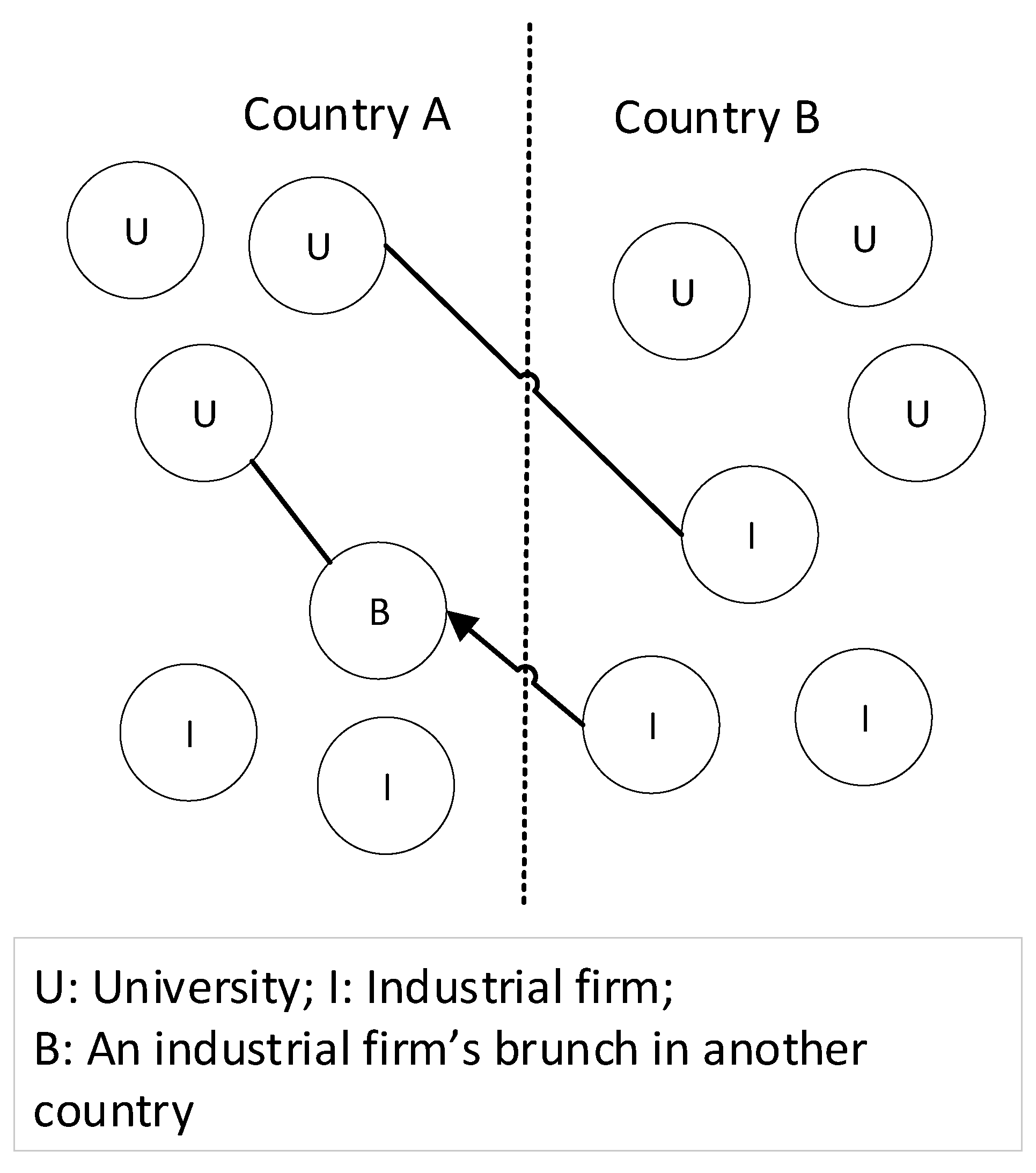
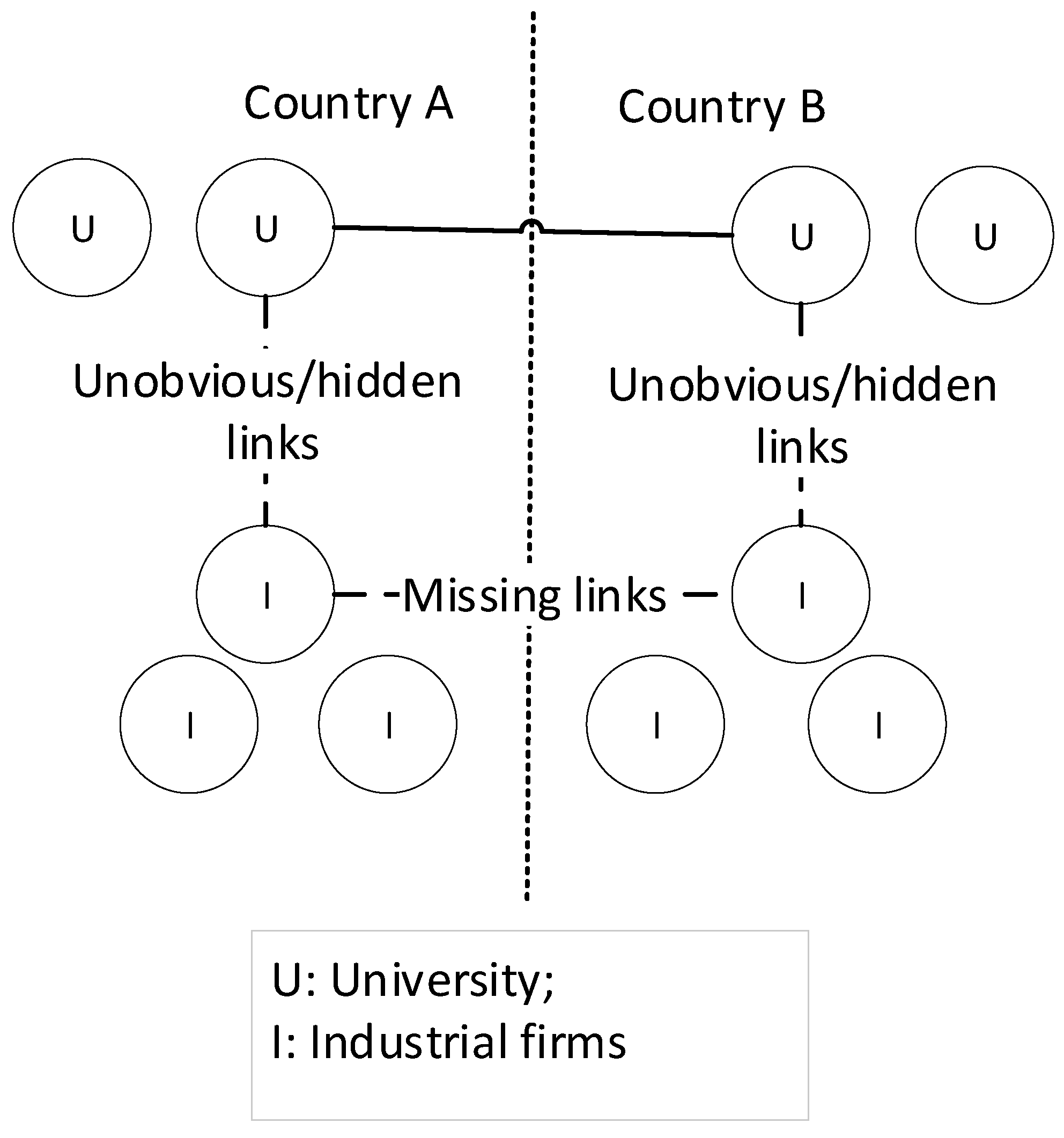
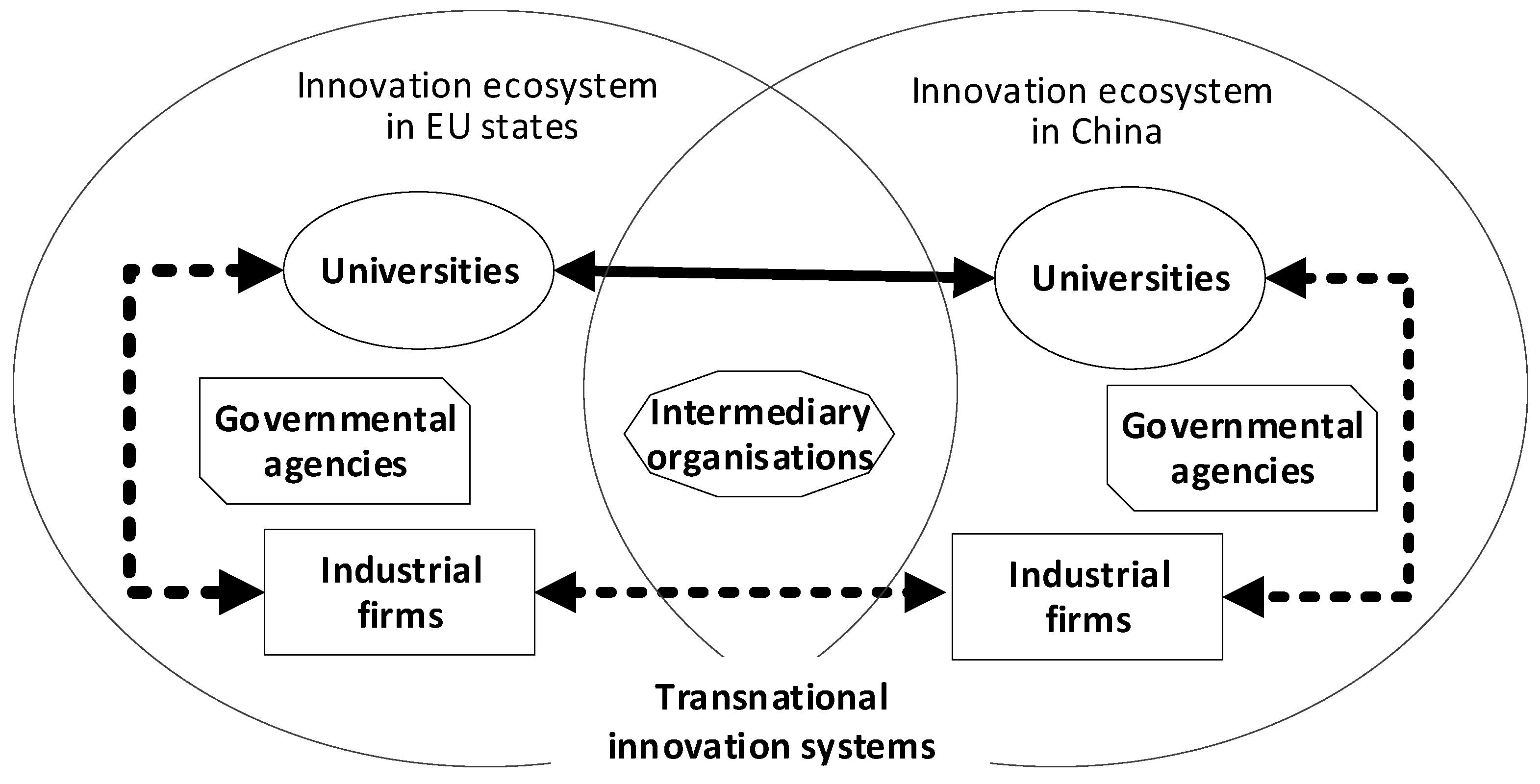
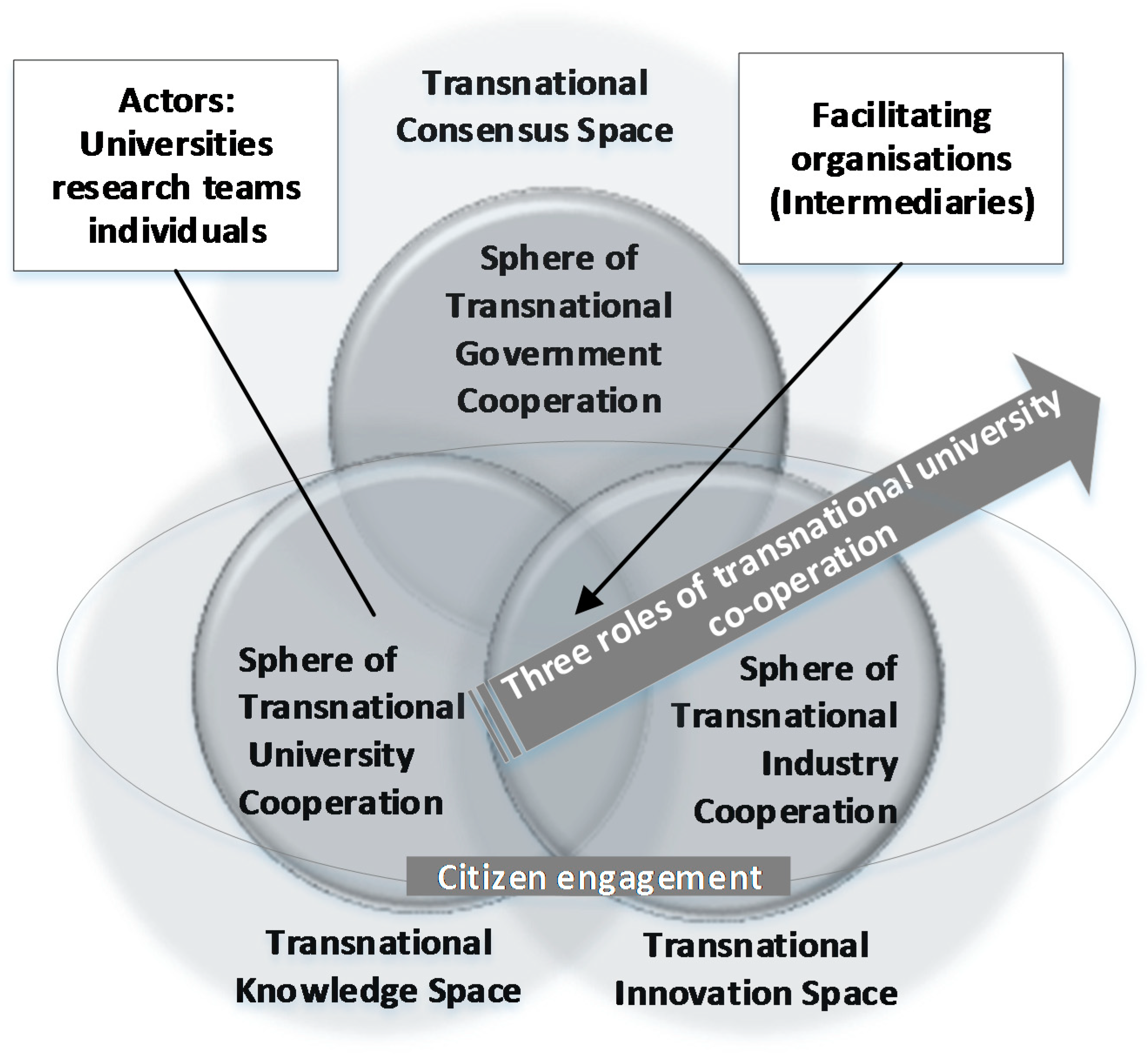
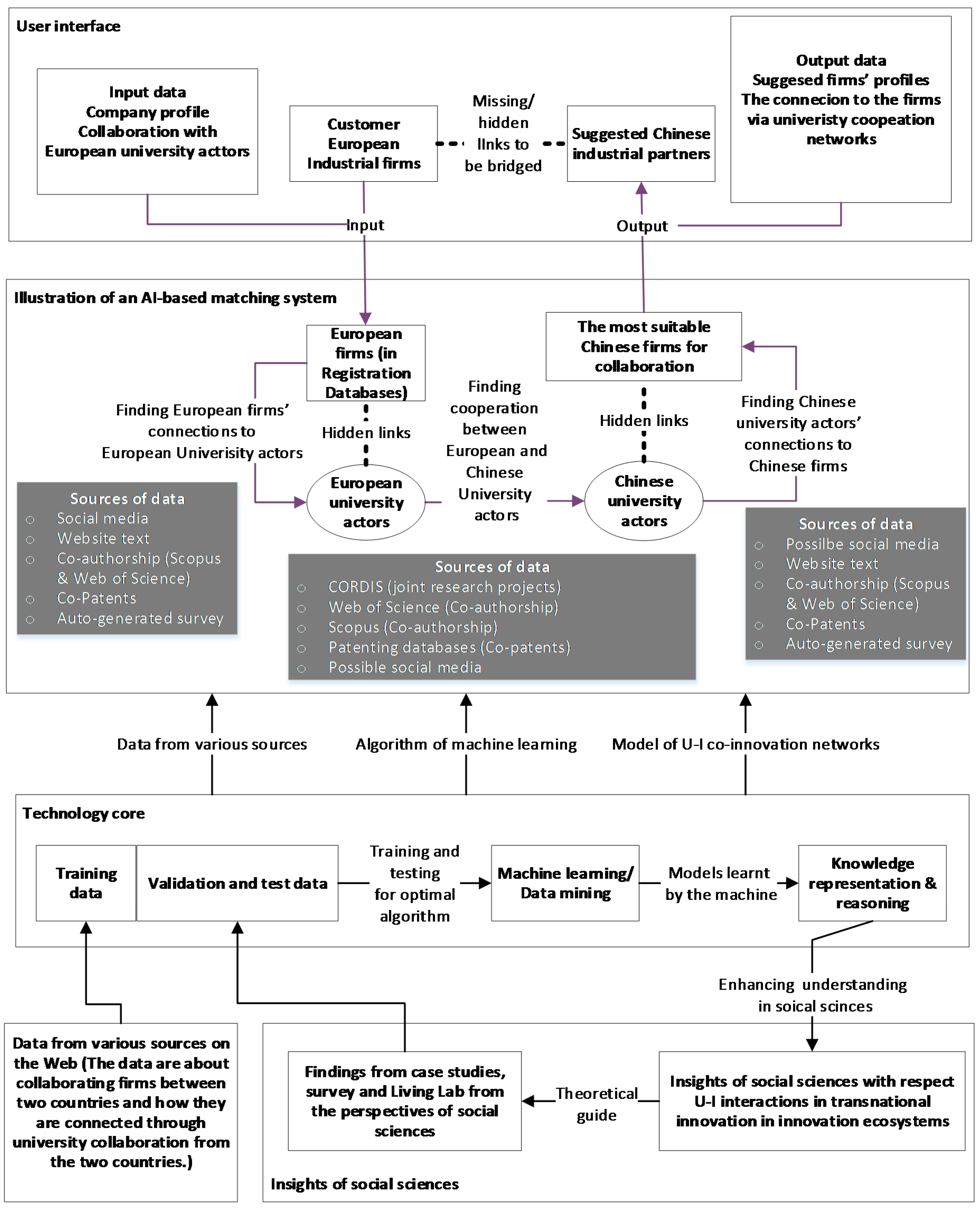
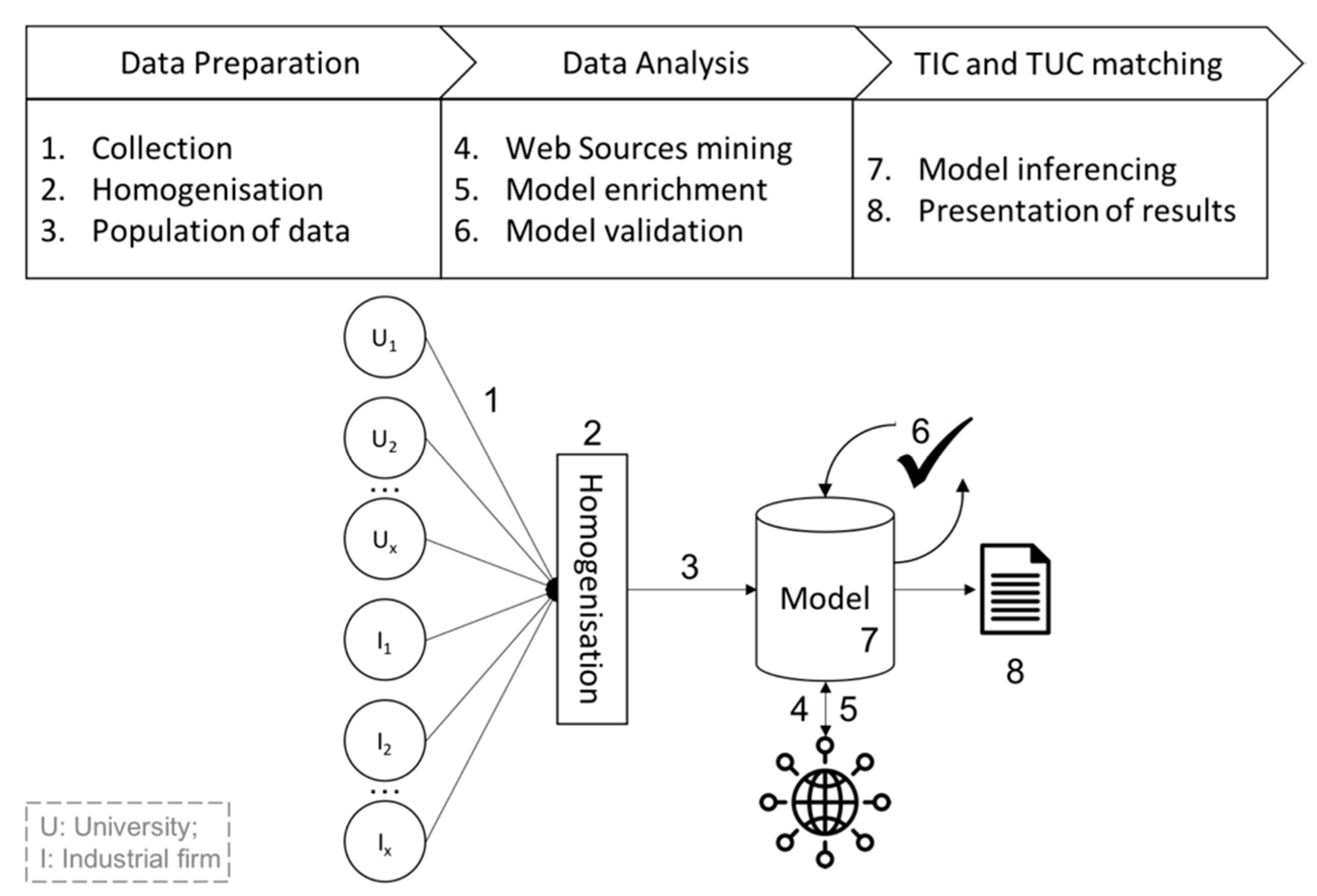
| Research Questions | Limitations of Existing Literature | Potential Contributions Offered by Our Proposed Approach |
|---|---|---|
| Why should TIC and TUC be looked at as synergetic entities? | The synergies between TIC and TUC are hypothetical. Scarce data are available for empirical exploration. | A large scale of transnational U–I co-innovation networks will be detected and developed. This will enable deep empirical investigations and even big data analyses. |
| How can the synergy building be theoretically elucidated? | The theories, to varying extents, elucidate the mechanisms underlying the synergy building between obvious actors crossing sectors/communities, but mainly in a domestic context. The relations between the actors are one to one (or one to more). | The AI algorithms will be based on integrating several social science theories, which provide theoretical foundations concerning developing collaborative relations (networks) between unobvious (cross-sectoral) actors in a transnational context. Our frameworks address the relations between different pairs of collaborators. |
| How can the synergy building be methodologically realized? | SNA: lacks efficiency in exploring hidden/missing links. Professional social matching (PSM): not for matching in a cross-sectoral and transnational context. AI technologies: no suitable algorithms and training data ready to use. | A comprehensive method will be developed by integrating social science studies and AI in the context of transnational innovation ecosystems. It is not only for detecting potential collaborators and links between them, but also for building the networks. |
© 2019 by the authors. Licensee MDPI, Basel, Switzerland. This article is an open access article distributed under the terms and conditions of the Creative Commons Attribution (CC BY) license (http://creativecommons.org/licenses/by/4.0/).
Share and Cite
Cai, Y.; Ramis Ferrer, B.; Luis Martinez Lastra, J. Building University-Industry Co-Innovation Networks in Transnational Innovation Ecosystems: Towards a Transdisciplinary Approach of Integrating Social Sciences and Artificial Intelligence. Sustainability 2019, 11, 4633. https://doi.org/10.3390/su11174633
Cai Y, Ramis Ferrer B, Luis Martinez Lastra J. Building University-Industry Co-Innovation Networks in Transnational Innovation Ecosystems: Towards a Transdisciplinary Approach of Integrating Social Sciences and Artificial Intelligence. Sustainability. 2019; 11(17):4633. https://doi.org/10.3390/su11174633
Chicago/Turabian StyleCai, Yuzhuo, Borja Ramis Ferrer, and Jose Luis Martinez Lastra. 2019. "Building University-Industry Co-Innovation Networks in Transnational Innovation Ecosystems: Towards a Transdisciplinary Approach of Integrating Social Sciences and Artificial Intelligence" Sustainability 11, no. 17: 4633. https://doi.org/10.3390/su11174633
APA StyleCai, Y., Ramis Ferrer, B., & Luis Martinez Lastra, J. (2019). Building University-Industry Co-Innovation Networks in Transnational Innovation Ecosystems: Towards a Transdisciplinary Approach of Integrating Social Sciences and Artificial Intelligence. Sustainability, 11(17), 4633. https://doi.org/10.3390/su11174633







